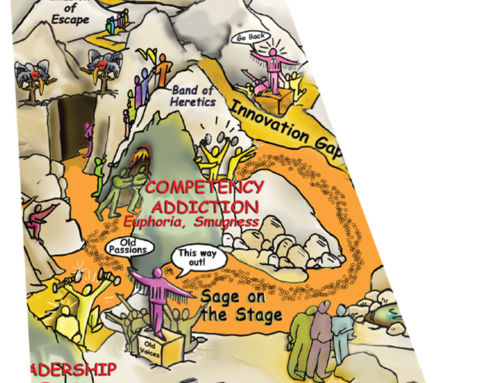The Second Law of the Future, “If something big is going to happen in the future, it has to start sometime” is no more evident than in these four Disruptive Shifts. They are each innovations that enable big changes to new forms and functions of work, particularly how people will interact to achieve results.
While the first four big disruptive shifts that are changing the future of work are described here, the second four are outlined below:
5. Desktop to the Device
 Devices have rapidly evolved to capture and hold enormous amounts of data, make complex information visible, and provide sufficient computational capability to substitute for desktop computers. They are becoming the main tool by which to share and connect. In work they connect colleagues with colleagues and support the ubiquitous mobility of workers. In healthcare they connect patients to doctors. In the global economy they connect workers as they move about the globe. Their affordability allows new competitors to pop up in every corner of the world, extending the global marketplace and challenging the common rules of competition. These new technologies are more social and create new platforms for how we stay in touch, complete work, and produce and create value. It creates a whole new world of collaboration at work.
Devices have rapidly evolved to capture and hold enormous amounts of data, make complex information visible, and provide sufficient computational capability to substitute for desktop computers. They are becoming the main tool by which to share and connect. In work they connect colleagues with colleagues and support the ubiquitous mobility of workers. In healthcare they connect patients to doctors. In the global economy they connect workers as they move about the globe. Their affordability allows new competitors to pop up in every corner of the world, extending the global marketplace and challenging the common rules of competition. These new technologies are more social and create new platforms for how we stay in touch, complete work, and produce and create value. It creates a whole new world of collaboration at work.
6. Permanent Relationships to Velcro Relationships
In the past, the ideal work relationship was a permanent one, where people would complete their whole careers in a single company or industry. Although this does still happen, there is a shift to a different, and now more preferable style: the Velcro relationship. Velcro attaches very strongly and holds together under tremendous pressure, but is temporary and when separated, leaves no damage. New work relationships increasingly function on this model. Employees and employers offer a relationship experience where they can leverage each other to complete a certain piece of work or experience. This relationship is built on the expectation that it will be strong and productive but will end at a defined, short period of time without damage to either party.
7. Outsourcing to Crowd sourcing
The distribution of work will continue unabated around the globe. Traditional outsourcing will not disappear, but it will become just one source of remote work with the advent of crowdsourcing. This new option for sourcing people, ideas, deals, and funding has rapidly emerged with the growth and sophistication of cloud technologies. Beginning as a solution to storage of information, the cloud allows us to scout for new talent, and when combined with other social media tools, assemble teams from any place to work together virtually, and source ideas for innovation from a huge – almost unlimited – diverse population that could never be matched inside a company. It makes anyone with Internet access available to participate in any number of ‘crowds.’ This new process and platform to find a myriad of solutions is built mainly on Velcro relationships.
8. Sharing Knowledge to Creating Context for Persuasive Conversations
As much of today’s knowledge becomes obsolete, the need to share knowledge as the top priority for seeding innovation and productivity becomes replaced with a higher priority of persuading people to change their minds and let go of old knowledge. The task at the forefront is to create new knowledge or use emergent knowledge to innovate and gain productivity. Leaders and managers must become skilled at creating context where these persuasive conversations can take place on an ongoing basis. The value derived from knowledge comes from having the combinatorial skills to consider multiple, accessible sources of information and create something from them. The era of big data and surges of new knowledge calls for a great deal more continuous adaptability of mindsets.
Parting Thoughts…
To thrive in the new future of work people must have adaptability and engage in lifelong learning. The landscape has dramatically changed. Disrupted by powerful cross-cutting drives of the transformation of work, eight big shifts have coalesced into a whole new environment of work. Individuals will need to continuously update and add skills. Business will need new strategies to assure they always have the skills in place to support their business goals. Educational institutions must shift old mindsets and learning experiences to match the new needs and especially to provide relevant accessible adult learning opportunities to the post-college graduate.



